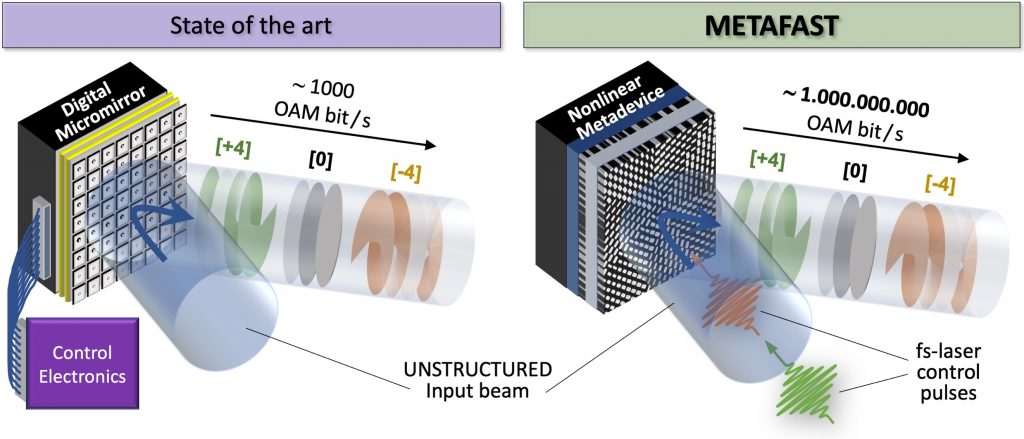METAsurfaces for ultraFAst light STructuring (METAFAST)
Modern optical links are the information highways of the planet, also referred to as the core or backbone optical network. At present, long-haul (hundreds of km) fiber optics connections are capable of an amazing 100-200 Gbit/s transmission rate per channel. However, the recent spreading of cloud services and the concentration of users’ digital information in big data centers are posing an increasing demand of additional capacity and reduced latency for distributed computation and faster bandwidth provisioning. The 5G radio technology, prospecting 1000 times more capacity compared to the current 4G, with end-to-end latency decreased to milliseconds at least for nearby end-points, is a promise for customers and end users, but such a development is hampered by the lack of capacity and infrastructure in the backhaul [3GPP, Technical Specification (TS) 38.xxx, 6 2019, version V15.6.0]. The backhaul is the network part that interconnects the access networks (where cellular devices are connected via wireless) with the backbone. A 5G base station is designed to support access capacity in excess of 100 Gbit/s, and the only reliable technology today to support such a capacity are optical fibers. The idea of installing an optical cable for each and every base station in 5G networks is one of the nightmares of operators, as the capital expense would be enormous. Research and investments in mmWave communications testify the scale of this problem, but mmWave technology can probably increase backhaul capacity by a factor of 10-100, leaving another two orders of magnitude to be gained before 5G can be fully deployed.

The backhaul is a classical metro-local level network, where free-space optics (FSO) links have been proposed to deliver high speed connection with the advantages of an easier installation/deployment compared to fiber-based systems, and a better protocol transparency and security compared to radio systems. Notwithstanding, the strong sensitivity to adverse weather conditions (especially fog and rain) has so far prevented the spreading of FSO links.

The state-of-the-art of SOAM modulation technology to date is largely based on liquid crystals or digital micromirrors, which suffer from intrinsic limits in terms of speed (of the order of thousands bit per second) and prevent real-world telecom applications (demanding billions bit per second data rate). Thanks to our novel approach to ultrafast light structuring via nonlinear optical metasurfaces we will tackle the formidable challenge of increasing by 6 orders of magnitude the speed of SOAM modulators. Such a result could provide the metropolitan optical network with the kind of speed, robustness and security requested to support the 5G radio technology, thus underpinning the forthcoming fourth industrial revolution with fast communications for the so-called internet of things.
